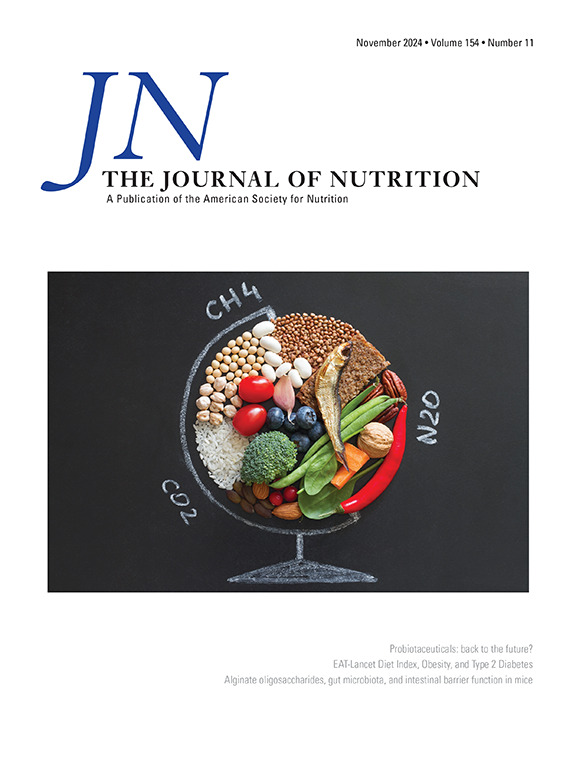与平时的摄入量相比,ke 可改善心血管代谢疾病风险增加的成年人的脂蛋白颗粒浓度:随机对照试验》。
IF 3.7
3区 医学
Q2 NUTRITION & DIETETICS
引用次数: 0
摘要
背景:食用山核桃可以持续改善脂蛋白,但很少有研究调查山核桃对脂蛋白亚组分的影响。目的:目的是研究用57克/天的山核桃替代常规零食对脂蛋白颗粒亚组分和载脂蛋白的影响,与12周后继续正常摄入相比。探索性分析评估了对胰岛素抵抗早期标志物的影响,包括脂蛋白胰岛素抵抗指数(LP-IR)、糖尿病风险指数(DRI)和GlycA。方法:在有心脏代谢疾病风险的成年人中进行了一项为期12周的随机、双臂平行试验。参与者被要求要么每天吃57克山核桃代替平时的零食,要么继续吃平时的零食。在基线和12周收集血浆样本,用质子核磁共振波谱分析脂蛋白、载脂蛋白和GlycA。用线性回归评估组间基线变化的差异。结果:共138名参与者(每组n=69)和130名参与者(山核桃组n=62;正常饮食组(n=68)完成试验。山核桃组的载脂蛋白B (apoB)浓度较基线有更大的降低(-4.38 mg/dL;95%CI -8.02, -0.73),总LDL (-75.3 nmol/L;95%CI -144, -6.93),总富甘油三酯脂蛋白(TRL-P) (-20.4 nmol/L;95%CI -33.8, -7.03),大(-1.47 nmol/L;95%CI -2.69, -0.26)和小(-11.3 nmol/L;95%CI -22.4, -0.27) TRL-P和LP-IR(-4.42点;95%CI为-8.14,-0.69),大密度脂蛋白浓度较基线增加更大(0.35 μmol/L;95%CI 0.07, 0.63)。结论:在饮食中加入57 g/天的山核桃,以取代通常的零食,持续12周,可改善有心脏代谢疾病风险的成年人的载脂蛋白ob、动脉粥样硬化脂蛋白亚组分和脂蛋白ir。临床试验注册:https://clinicaltrials.gov/study/NCT05071807;NCT05071807。本文章由计算机程序翻译,如有差异,请以英文原文为准。
Pecan Intake Improves Lipoprotein Particle Concentrations Compared with Usual Intake in Adults at Increased Risk of Cardiometabolic Diseases: A Randomized Controlled Trial
Background
Pecan consumption consistently improves lipoproteins, but less research has investigated the effect of pecans on lipoprotein subfractions.
Objectives
The aim was to investigate the effect of substitution of usual snack foods with 57 g/d of pecans on lipoprotein particle subfractions and apolipoproteins compared with continuing usual intake after 12 wk. Exploratory analyses evaluated effects on early markers of insulin resistance including the Lipoprotein Insulin Resistance Index (LP-IR), Diabetes Risk Index, and GlycA.
Methods
A 12-wk, randomized, 2-armed parallel trial in adults at risk of cardiometabolic disease was conducted. Participants were instructed to either consume 57 g/d of pecans in place of usual snacks or to continue their usual intake. Plasma samples collected at baseline and 12 wk were analyzed for lipoproteins, apolipoproteins, and GlycA by proton nuclear magnetic resonance spectroscopy. Between-group differences in the change from baseline were evaluated with linear regression.
Results
In total, 138 participants were randomly assigned (n = 69 per group) and 130 participants (pecan group n = 62; usual diet group n = 68) completed the trial. The pecan group had a greater reduction from baseline in the concentrations of apolipoprotein B (apoB) [–4.38 mg/dL; 95% confidence interval (CI): –8.02, –0.73], total low-density lipoprotein particles (–75.3 nmol/L; 95% CI: –144, –6.93), total triglyceride-rich lipoprotein particles (TRL-P) (–20.4 nmol/L; 95% CI: –33.8, –7.03), large (–1.47 nmol/L; 95% CI: –2.69, –0.26) and small (–11.3 nmol/L; 95% CI: –22.4, –0.27) TRL-P and the LP-IR (–4.42 points; 95% CI: –8.14, –0.69), and greater increases from baseline in the concentration of large high-density lipoprotein particles (0.35 μmol/L; 95% CI: 0.07, 0.63) compared with the usual diet group.
Conclusions
Incorporating 57 g/d of pecans into the diet in place of usual snacks for 12 wk improved apoB, atherogenic lipoprotein subfractions, and the LP-IR in adults at risk of cardiometabolic diseases.
This trial was registered at clinicaltrials.gov as NCT05071807.
求助全文
通过发布文献求助,成功后即可免费获取论文全文。
去求助
来源期刊

Journal of Nutrition
医学-营养学
CiteScore
7.60
自引率
4.80%
发文量
260
审稿时长
39 days
期刊介绍:
The Journal of Nutrition (JN/J Nutr) publishes peer-reviewed original research papers covering all aspects of experimental nutrition in humans and other animal species; special articles such as reviews and biographies of prominent nutrition scientists; and issues, opinions, and commentaries on controversial issues in nutrition. Supplements are frequently published to provide extended discussion of topics of special interest.
 求助内容:
求助内容: 应助结果提醒方式:
应助结果提醒方式:


